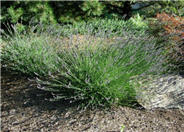
Common name:English Lavender
Botanical name:Lavandula angustifolia
English lavender is a dependably hardy, heat tolerant, drought resistant perennial, well suited to our arid, cold climate. Aromatic, green to grey-green foliage has a rich, resin scent, and grows in tight clumps 1 to 2 feet in height and width, depending on variety. Flowers form at the ends of stiff stems, in whorls of blue to lavender to purple, again, depending on variety. Flowers may add another 6 to 12 inches of height. Use in any sunny spot, such as perennial border, herb garden, parkstrip, lining a pathway.
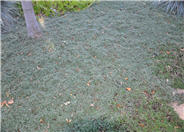
Common name:Woolly Thyme
Botanical name:Thymus lanuginosus
Woolly Thyme is a perennial groundcover growing in a low mat, typically under 2 inches, but spreading 16 inches or more. Foliage is fuzzy and gray-green during the summer months, and tinged with a lovely burgundy hue in the fall and winter. An evergreen thyme, it makes a wonderful groundcover, even an alternative to turf, in low traffic areas. And as it tolerates some foot traffic, its wonderful between pavers and along pathways. It has a pink summer bloom, though it rarely flowers; the lovely fall color fills the void.
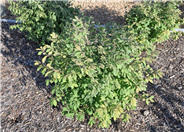
Common name:Compact Burning Bush
Botanical name:Euonymus alatus 'Compacta'
"Compacta" is a dwarf form of burning bush, growing 6 to 8 feet tall and wide. Like the speices, leaves emerge in the spring a bright, luminous green, mature to a dullish medium to dark green, and turn a brilliant scarlet to burgundy in the fall. After the leaves drop, the interesting wood is exposed, with corky "wings" along the length of the stems. New wood displays green and brown wood, older wood is a warm grey brown. Little yellow flowers appear May and June, and though not showy, they are charming.
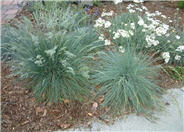
Common name:Blue Fescue
Botanical name:Festuca ovina glauca
This group of ornamental grasses generally grow less than a foot tall and have fine, green to blue-green, evergreen leaves that are very thin and hair-like. Flowers appear in the summer and have an airy and open appearance. Prefers full sun but will tolerate afternoon shade if not over-watered. It needs well draining soil and is drought tolerant once it's established. An evergreen, it may need tidying up in the spring; trim out dead foliage and seed heads.
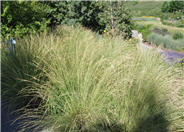
Common name:Switch Grass
Botanical name:Panicum virgatum
Switch grass is a north American native and an original component of the Midwestern Plains. It is a warm-season (it goes dormant during the winter) clumping grass with an upright form, interesting flowers, showy fall color, and a great winter presence. It grows from 4 to 7 feet tall and about half as wide, though in time may spread wider. Airy, delicate flowers appear in mid-summer, hanging along an arching, wiry stem, and are pink to red to orange. Foliage turns yellow to orange in the fall, and the flowers turn a silvery white. there are now many cultivars to choice from, and they all make excellent and low-care additions to perennial or shrub borders, or in more naturally styled settings.

Common name:Karl Foerster Feather Reed Grass
Botanical name:Calamagrostis acutiflora 'Karl Foerster'
Karl Foerster feather reed grass is a garden favorite, and for good reason. Its green, fine-textured foliage is gently arching and grows to about 2 feet tall and wide. Oat-like plumes stand very erect over the foliage, growing as tall as 5 to 6 feet. Plumes open whiteish green, later turning a dusky rose, and then tawny colored by winter. Blooms early summer with the plumes lasting into autumn. Holds its presence well into winter. Excellent in mixed perennial or shrub borders, or massed.
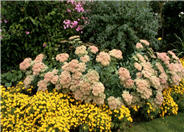
Common name:Autumn Joy Sedum
Botanical name:Sedum 'Autumn Joy'
Autumn Joy sedum is a garden staple, and for good reason. Emerging in early spring, fleshy, green to grey-green leaves form a rosette of foliage, and soon expands on sturdy stems, growing about 18 to 24 inches tall and wide. Flower heads begin to form in early to mid summer, looking something like little cauliflower, but soon the buds open to pale pink stars that progressively deepen in color, until they become a russet red in the fall. Use in perennial, shrub, or foundation borders, in parkstrips, with ornamental grasses. Attracts butterflies and bees. Flower heads persist well into winter.

Common name:Hummingbird Trumpet; Fire Chalice
Botanical name:Zauschneria latifolia
Eye-catching as red lipstick, little red-orange trumpets stand out from leafy stems, creating a lovely sphere of color that lasts from mid-summer to frost. Native to droughty, rocky places at higher elevations, it also makes its home along waterways, indicating that a little additional water will be appreciated and used to extend the flowering season. Fire Chalice will form a slightly woody perennial base then die back to the ground with the coming of the first hard frosts. Grows 12 to 18 inches tall and about 24 to 36 inches wide.
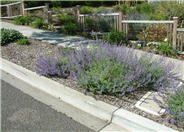
Common name:Catmint
Botanical name:Nepeta x faassenii
Catmint makes soft, grey-green, rounded mounds from 10 to 24 inches high, depending on variety. Most will be wider than tall. This perennial has lavender blue flowers from late spring to early summer, though if you shear off the first flowers, it will frequently bloom again later in the summer. Different varieties have slightly different bloom times. Leaves are attractive, crinkled blue-grey and are aromatic.
| Designer: | Misc 55 |
Photographer: GardenSoft |
Water Saving Tip:
Fix leaking sprinklers, valves, and pipes.
One broken spray sprinkler can waste 10 gallons per minute - or 100 gallons in a typical 10 minute watering cycle.
